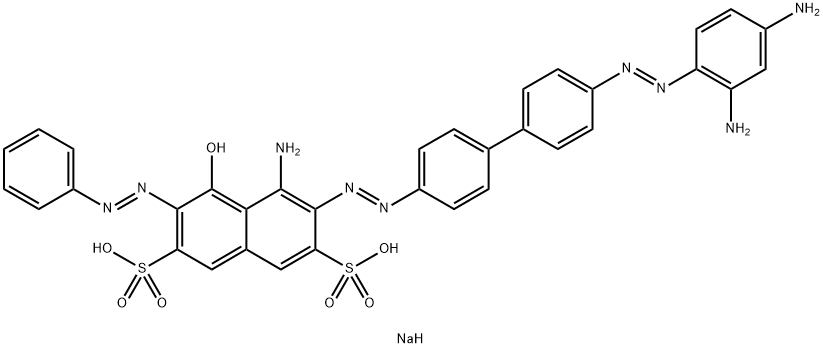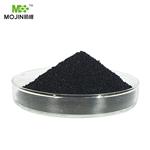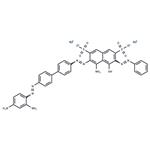Direct black 38 is a black powder. An AZOcompound. Molecular weight= 781.78; Freezing/Meltingpoint $ 400℃. Hazard Identification (based on NFPA-704M Rating System): Health 1, Flammability 1, Reactivity 0.Slightly soluble in water.
Chlorozol Black E is a chitin-specific stain and used to detect fungal filaments. Dyes and metabolites, Environmental Testing.Environmental toxin on US EPA Toxic Release Inventory list (TRI) list.
4-(4-Aminophenyl)benzenamine double nitriding, in acid conditions and 4-Amino-5-hydroxynaphthalene-2,7-disulfonic acid?coupling, aniline diazo, in alkaline conditions and 4-Amino-5-hydroxynaphthalene-2,7-disulfonic acid?group of adjacent a coupling, product again with Benzene-1,3-diamine coupling.
Gray-black microcrystals or black powder.
Azo dyes can be explosive when suspended in air at specific concentrations. Slightly soluble in water.
Direct Black 38 is an azo compound. Azo, diazo, azido compounds can detonate. This applies in particular to organic azides that have been sensitized by the addition of metal salts or strong acids. Toxic gases may form with acids, aldehydes, amides, carbamates, cyanides, inorganic fluorides, halogenated organics, isocyanates, ketones, metals, nitrides, peroxides, phenols, epoxides, acyl halides, and strong oxidizing or reducing agents. Flammable gases form with alkali metals. Explosive combination can occur with strong oxidizing agents, metal salts, peroxides, and sulfides. Incompatible with strong acids [NTP, 1992)].
Confirmed carcinogen. Moderately toxic
by ingestion and inhalation. An eye irritant.
ACUTE/CHRONIC HAZARDS: Direct Black 38 may be absorbed through the skin. When heated to decomposition it emits very toxic fumes of nitrogen oxides, disodium oxide and sulfur oxides.
Flash point data for Direct Black 38 are not available; however, Direct Black 38 is probably combustible.
Confirmed carcinogen
with carcinogenic and tumorigenic data.
Moderately toxic by ingestion and
inhalation. An eye irritant. Mutation data
reported. When heated to decomposition it
emits very toxic fumes of NOx, Na2o, and
so2.
Mutagen; Human Data. Direct black38 is an azo compound and is used to dye fabric, leather,cotton, cellulosic materials, and paper; these are then usedin consumer products. The chemical may be used by artists(CPSC, EPA). The FDA has indicated that although directblack 38 is identified in the literature as a hair-dye component, it is currently not used by the cosmetic industry. Inview of a health hazard alert issued in December 1980 byOSHA, which cautioned workers and employers of the carcinogenic effect of benzidine-derived direct black 38,new nonbenzidine direct black dyes have been developedand used successfully in commercial applications by thepaper and leather industry. These nonbenzidine dyes weredeveloped with the hope of replacing benzidine-based dyesthroughout industry.
Skin Contact: Flood all areas of the body thathave contacted the substance with water. Do not wait toremove contaminated clothing; do it under the water stream.Use soap to help assure removal. Isolate contaminatedclothing when removed to prevent contact by others. EyeContact: Remove any contact lenses at once. Flush eyeswell with copious quantities of water or normal saline for atleast 2030 min. Seek medical attention. Inhalation: Leavecontaminated area immediately; breathe fresh air. Properrespiratory protection must be supplied to any rescuers. Ifcoughing, difficult breathing or any other symptomsdevelop, seek medical attention at once, even if symptomsdevelop many hours after exposure. Ingestion: If convulsions are not present, give a glass or two of water or milk todilute the substance. Assure that the person’s airway isunobstructed and contact a hospital or poison center immediately for advice on whether or not to induce vomiting.
Color Code—Blue: Health Hazard/Poison: Storein a secure poison location. Store in a cool, dry place. Aregulated, marked area should be established where thischemical is handled, used, or stored in compliance withOSHA Standard 1910.1045.
Properties and Applications
black. Palm black powder. Soluble in water for green light black, solubility 40 g/l (85 ℃), and adequate soluble in alcohol for green light blue-black, right amount soluble in soluble fiber element, insoluble in other organic solvents. The strong sulfuric acid is a deep red in blue, diluted Purple dark reddish brown for to red light black precipitation; In nitric acid solution for yellow brown (not completely); In strong hydrochloric acid for dark red light black solution (don’t). The dye solution to join strong hydrochloric acid for Purple dark reddish brown, precipitation; Concentrated sodium hydroxide solution is generated gray light blue precipitaten. Cellulose fiber of dyeing, the dye absorption rate as well, in 80 ℃ temperature when the biggest affinity. Can discharge. Used for cotton, viscose, silk, polyamide fiber and its blending fabric, leather, wood, biological and plastic color, also used as the raw material of black ink.
|
Standard
|
Acid Resistance
|
Alkali Resistance
|
Light Fastness
|
Soaping
|
Water
|
|
Fading
|
Stain
|
Fading
|
Stain
|
|
ISO
|
3
|
3
|
3
|
2
|
|
2-3
|
|
|
AATCC
|
3
|
3
|
4-5
|
3
|
|
2
|
|
Azo dyes can form explosive mixtures inair, especially if sensitized with metal salts and/or strongacids. Contact with alkali metals forms explosive gases.Contact with oxidizers and reducing agents forms toxicfumes and gases; also with acids, acryl halides, aldehydes,amides, carbamates, cyanides, epoxides, fluorides (inorganic), halogenated organic materials, isocyanates, ketones,metals, nitrides, peroxides, phenols. May form explosivemixtures with oxidizers, metal salts, peroxides, and sulfides.



